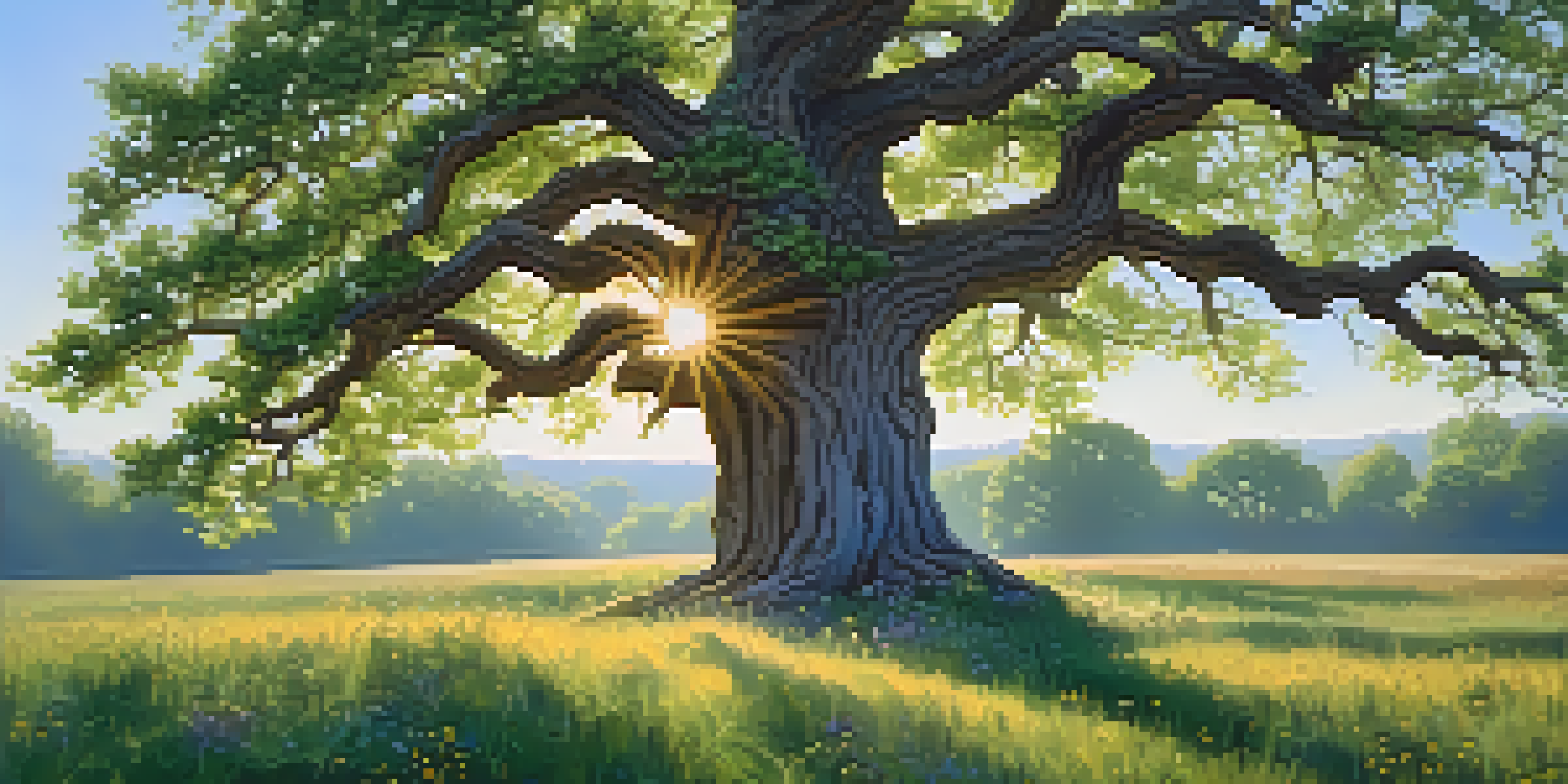The Representation of Trees in American Literature

The Symbolic Role of Trees in American Literature
Trees have long been a potent symbol in American literature, representing various themes such as growth, strength, and endurance. They often stand as witnesses to human experiences, embodying the passage of time and the cycles of life. From the mighty oak to the delicate willow, each tree type conveys a unique message, enriching narratives and deepening character development.
The clearest way into the Universe is through a forest wilderness.
In many works, trees serve as a backdrop for pivotal moments, acting as silent observers to the joys and sorrows of human existence. For instance, in 'The Giving Tree' by Shel Silverstein, the tree's selflessness illustrates the themes of unconditional love and sacrifice. The contrast between the tree's enduring nature and the boy's evolving needs highlights the complexities of relationships.
Moreover, trees reflect the American landscape, symbolizing the connection between nature and identity. They evoke a sense of place, grounding the story in a specific locale, while also linking the characters to their heritage and environment. This intertwining of human and natural worlds enhances the richness of the narrative, inviting readers to explore deeper meanings.
Trees as Symbols of Resilience and Survival
In American literature, trees often embody resilience, thriving in challenging conditions and inspiring characters to overcome obstacles. This symbolism resonates deeply in stories of survival, where trees represent hope and the possibility of renewal. For example, in the works of authors like Toni Morrison, trees serve as metaphors for the strength and endurance of African American communities.

Morrison's novel 'Song of Solomon' features a tree that symbolizes familial ties and heritage, grounding characters in their collective past. The tree stands as a testament to the resilience of those who came before, reminding characters of their roots and the importance of legacy. Such representations of trees highlight the intertwined nature of identity and survival.
Trees Symbolize Growth and Resilience
In American literature, trees serve as powerful symbols of growth, endurance, and the human capacity to overcome challenges.
Additionally, trees can symbolize the struggle against adversity, showcasing how characters adapt and grow despite challenges. This theme encourages readers to reflect on their own resilience, fostering a sense of empowerment. Trees, in this context, become more than just figures in the landscape; they transform into powerful symbols of human strength and perseverance.
Cultural Significance of Trees in Native American Literature
Trees hold profound cultural significance in Native American literature, often representing life, spirituality, and interconnectedness. Many Native American cultures view trees as sacred beings, embodying wisdom and serving as vital sources of sustenance. This reverence is reflected in stories that emphasize the relationship between humans and nature, highlighting the importance of respecting the natural world.
He that plants trees loves others besides himself.
In the works of authors like Louise Erdrich, trees become central to the narrative, symbolizing the connection to ancestry and the land. For instance, in 'Love Medicine,' the presence of trees signifies the continuity of life and the enduring bonds between generations. Such depictions remind readers of the deep-rooted ties between identity and environment in Native American cultures.
Moreover, trees often serve as metaphors for healing and renewal in Native American storytelling. They embody the cyclical nature of life, where death leads to new beginnings. This perspective encourages a holistic understanding of existence, emphasizing the importance of harmony between people and the earth. Through these narratives, trees become powerful symbols of cultural identity and resilience.
Trees in Modern American Literature: A Reflection on Society
In contemporary American literature, trees often serve as mirrors reflecting societal issues and personal struggles. Authors utilize the imagery of trees to explore themes of environmentalism, urbanization, and the impacts of industrialization. This shift highlights the growing awareness of ecological concerns and the need to reconnect with nature.
For instance, in Richard Powers's novel 'The Overstory,' trees play a crucial role in connecting the lives of diverse characters, illustrating the interconnectedness of humanity and nature. The narrative emphasizes the urgency of environmental conservation, prompting readers to reflect on their relationship with the natural world. Trees, in this context, become symbols of both fragility and resilience.
Cultural and Spiritual Significance
Trees hold deep cultural meaning in Native American literature, representing life, spirituality, and the interconnectedness of identity and environment.
Moreover, trees can symbolize personal growth and transformation in the face of societal challenges. Characters often find solace and clarity beneath their branches, using these natural elements as spaces for reflection and healing. This exploration of trees as personal sanctuaries resonates with readers, inviting them to consider their own moments of introspection and growth.
Trees as Characters: Personification in Literature
The personification of trees is a powerful literary device that allows authors to imbue these natural beings with human-like qualities. By giving trees emotions, thoughts, and desires, writers create a deeper connection between the reader and the natural world. This technique invites readers to empathize with trees, fostering a sense of stewardship for nature.
In 'The Giving Tree,' for example, the tree's self-sacrifice and unconditional love resonate with readers on a personal level. This personification elevates the tree from a mere backdrop to a central character, challenging readers to consider the implications of human interactions with nature. Such narratives provoke reflection on themes of love, loss, and the consequences of exploitation.
Similarly, in J.R.R. Tolkien's 'The Lord of the Rings,' the Ents—tree-like beings—serve as guardians of the forest, embodying the struggle against industrialization. Their personification highlights the importance of nature's voice in an increasingly mechanized world. Through these character-driven representations, trees become symbols of resistance and guardianship, reminding readers of the vital role nature plays in the balance of life.
The Role of Trees in American Poetry
Trees occupy a prominent place in American poetry, often symbolizing beauty, transience, and the passage of time. Poets use trees to evoke emotions and create vivid imagery that resonates with readers. The delicate interplay between nature and human experience is beautifully captured in works by poets like Robert Frost and Emily Dickinson.
Frost's poem 'Birches' illustrates the nostalgia and longing for simplicity through the imagery of bending trees. The act of swinging through the branches serves as a metaphor for escaping the complexities of adulthood, reflecting the desire for freedom and innocence. Such portrayals invite readers to connect with their own memories and feelings associated with nature.
Environmental Awareness Through Trees
Contemporary literature increasingly uses trees to address environmental themes, emphasizing the need for conservation and humanity's relationship with nature.
Similarly, Dickinson often uses trees as symbols of mortality and nature's cyclical beauty. In her poems, trees embody the tension between life and death, reminding readers of the inevitable passage of time. This exploration of trees in poetry highlights their role as a source of inspiration, contemplation, and emotional resonance.
Environmental Themes: Trees in American Literature
As environmental awareness has grown, trees have increasingly emerged as central themes in American literature. Authors leverage tree symbolism to address pressing issues such as deforestation, climate change, and the human impact on nature. This literary shift reflects a broader societal acknowledgment of the need for ecological stewardship.
Books like 'The Overstory' by Richard Powers exemplify this trend, weaving together multiple narratives that highlight the significance of trees in sustaining life. The interconnected stories underscore the urgency of protecting forests and biodiversity, prompting readers to consider their own roles in environmental conservation. Trees, in this context, become powerful symbols of both vulnerability and resilience.

Furthermore, literature often portrays trees as symbols of hope and renewal amid environmental crises. They serve as reminders of nature's capacity for regeneration and the possibility of healing the planet. This hopeful perspective encourages readers to envision a future where humanity coexists harmoniously with nature, emphasizing the collective responsibility to protect the earth.